 When a social media platform introduces a new feature, being among the early adopters can be crucial for marketing success. Incorporating the latest functionality into social content before your competition can help your posts stand out and gain more traction from the changes, attracting more followers and increasing your overall visibility on the site. This is especially true in student recruitment, where schools are more likely to have a younger, more digitally informed audience to keep up with.
When a social media platform introduces a new feature, being among the early adopters can be crucial for marketing success. Incorporating the latest functionality into social content before your competition can help your posts stand out and gain more traction from the changes, attracting more followers and increasing your overall visibility on the site. This is especially true in student recruitment, where schools are more likely to have a younger, more digitally informed audience to keep up with.
The last few months have seen a number of interesting new features introduced to popular social media apps Snapchat, Twitter, and Instagram, as the companies have sought to gain ground on one another in an increasingly competitive marketplace. These aren’t just small updates either, with each platform dramatically increasing their functionality, offering new possibilities for both brands and users, and widening their potential audiences.
Want to know what’s new in social media, and how it could help your student recruitment campaigns? Read on to find out.
1. Using Instagram Stories for Student Recruitment: The Best of Snapchat and Instagram in One?
For many, the social media story of the last few years has been the rise of Snapchat. The immediacy and authenticity of the app, with its short lived ‘self destructing’ posts, captured the imagination of millions of millennials who had grown tired of established social media sites.
With the platform now said to enjoy as many as 150 million daily users, other social media sites have begun to sit up and take notice, even going so far as to try and imitate some of the app’s functionality in order to regain lost ground.
Instagram Stories might be the most explicit attempt to win over Snapchat users by any social media site so far. The new feature, which was rolled out in August, is almost identical to Snapchat Stories, allowing users to post multiple picture and videos to a feed separate from their main Instagram profile grid, all of which disappear after 24 hours. Stories are displayed on a showreel that appears above each user’s newsfeed until they expire.
While it has been criticised for bearing so many similarities to the Snapchat version, Instagram Stories may well offer a number of advantages over its rival when it comes to social media marketing for schools. For a start, Instagram is still a far more popular platform, with double the amount of daily users. Instagram is also far more accommodating and welcoming to brands, with Snapchat still perceived as more of a personal platform for close friends. If the feature is successful, schools that have used Snapchat Stories successfully can transfer their tactics to Instagram and expect to potentially double their engagement.
Example: The University of Michigan have frequently used Snapchat to good effect, featuring fun, engaging montages like the one below, which featured highlights from a charity dance marathon which took place on campus. Instagram Stories will allow schools to showcase content like this to a much wider audience.

But Stories is far more than just Snapchat with improved reach. For a start, it’s the first Instagram feature to include rudimentary analytics, allowing you to see who is engaging with your stories and refine and target your initiatives.
In addition, while it’s currently not possible to like or comment on individual stories, prospective leads can send direct messages to your account when they view your posts, offering another possible avenue of engagement. Stories also allow users to overlay text on images, which some schools have already used to good effect to add marketing messages to their photos. Not only that, but unlike Snapchat’s version, users have the option of pausing and rewinding an individual Story, making it far more user-friendly.
Example: New York University have been among the first schools to make use of Instagram Stories, taking advantage of the new text overlay options to enhance scenic shots of their campus and city.

Stories also offers the potential for recruiters to be more playful with their Instagram feeds. While Instagram has always been associated with perfectly crafted, stylised presentation, the disappearing feed allows you to take more risks. Instagram allows users to post snippets of their story on their timeline to promote it, and schools could use this to test new tactics, seeing what attracts the most engagement from users before rolling it out on their main feeds. Instagram also has more flexible privacy settings than Snapchat, meaning schools can exclude certain followers from seeing their posts, allowing them to potentially target Stories to specific demographics in their audience.
Stories is still in its early days, and has some disadvantages next to Snapchat, such as a slightly less wide variety of filter options, but this may change as it continues to develop. Ultimately, however, Instagram’s success in getting users to embrace the feature will largely determine how useful it is for your recruitment campaigns.
2. Twitter Moments Could Help Your School Make Headlines
Twitter has also been looking to Snapchat for inspiration when it comes to incorporating new, more real-time aspects intro their platform. Twitter Moments, which was introduced late last year, features curated collections of content built around newsworthy topics, in a similar way to Snapchat’s Live Stories, which focuses on live events.
While Moments were previously compiled by Twitter’s in-house team, the site recently announced that it would be rolling out the feature for public use, first to a selection of brands and influencers, and then finally to all its users in the coming months.
The feature could provide recruiters with a fresh, unique way to promote their institution on Twitter. If schools are given free rein to create their own Moments, the focus on events could be ideal for everything from open days to application deadlines, as well as highlighting events unique to their school to help differentiate themselves from their competition.
What’s more, the amplified reach that Moments affords to featured posts could help recruiters capitalise on news which generates positive publicity for their school, such as university rankings.
Example: Twitter recently featured a Moment highlighting the release of the U.S. News & World Report and MONEY National University rankings. A number of tweets from official university accounts, students, and alumni were featured in the Moment, affording those schools some great exposure. Here you can see Tweets relating to Howard University and the University of Michigan’s inclusions.
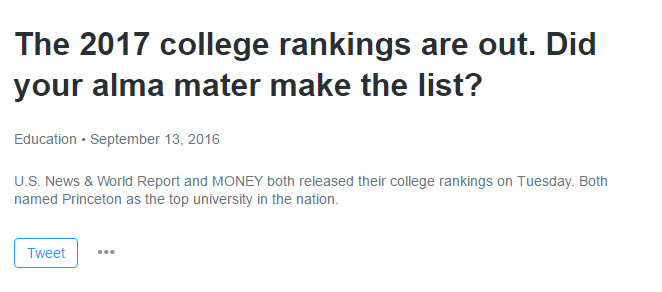
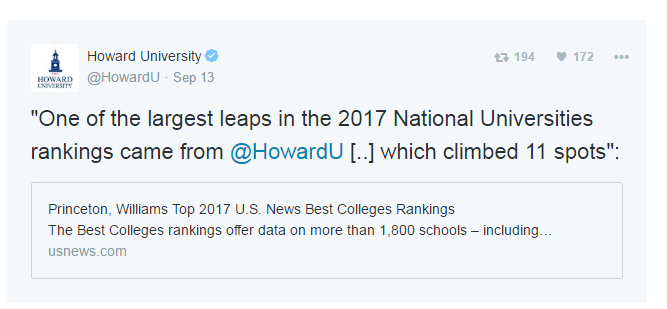

So how can schools increase their chances of featuring in Moments like this? Refocusing your Tweets around more topical events will certainly help, but it’s also important to ensure that you post in a number of different formats. The best curators will assemble Moments featuring a wide variety of text, images, gifs, videos, and links to hold users’ interest, and providing something different and interesting will make them more likely to include your posts.
Although some experts see Moments as an attempt to win over the Snapchat audience, it could be said that the feature has more to do with consolidating Twitter’s status as the go-to social media platform for breaking news. And while Bloomberg recently reported that Snapchat has surpassed Twitter in daily users, most don’t really use it for news, with a recent NewsCred Quantitative Study revealing that 55% rarely or never view Live Stories. Twitter may well prove to be a far more natural fit for the format, offering recruiters much more potential to maximise their reach.
Make a Lasting Impression on Recruits with Snapchat Memories
Interestingly, as other platforms have moved to imitate Snapchat’s approach to social media, the company themselves have begun to pull in the opposite direction. August saw the launch of Snapchat Memories, a new feature that marks a significant departure from the app’s original, instantaneous functionality.
With Memories, Snapchat users can search for previous stories they’ve added to the app and reshare them to their followers, meaning posts will now have a much longer potential shelf life. They can also import photos from their phones’ camera roll, and even save new photos to Memories so they can return to them and edit them later before posting.
Although there are some concerns that Memories will diminish Snapchat’s unique selling point as an unfiltered, unpolished social communication tool, the feature could potentially make the app much more brand-friendly, particularly for student recruitment.
Given Snapchat’s younger user demographic, many schools have been very keen to maximise its potential to generate more student inquiries, but have found its short-term functionality made it difficult to get real ROI from the platform.
Memories offers recruiters the chance to present more carefully edited posts and, crucially, to reshare their best content at a later date, retargeting and remarketing to new prospects to dramatically increase each post’s potential reach.
Example: New York University’s HashtagNYU account on Snapchat frequently features some great, engaging material, such as these snaps taken from the campus’s Grey Art Gallery. With Memories, good posts like these can be reused in the future, rather than simply disappearing at the end of the day.
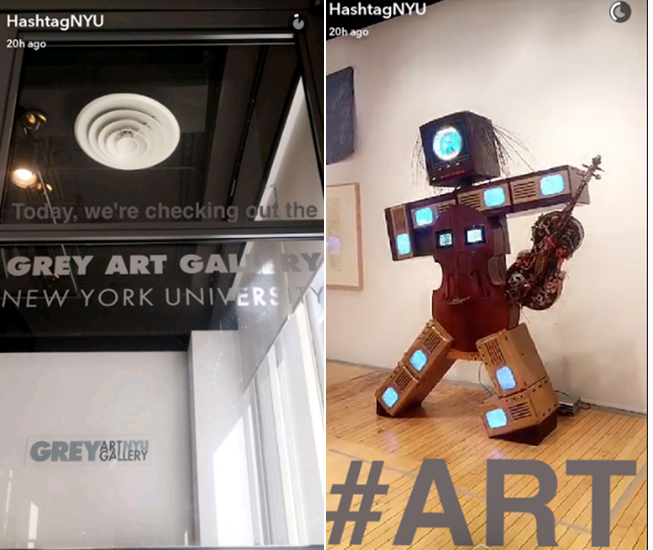
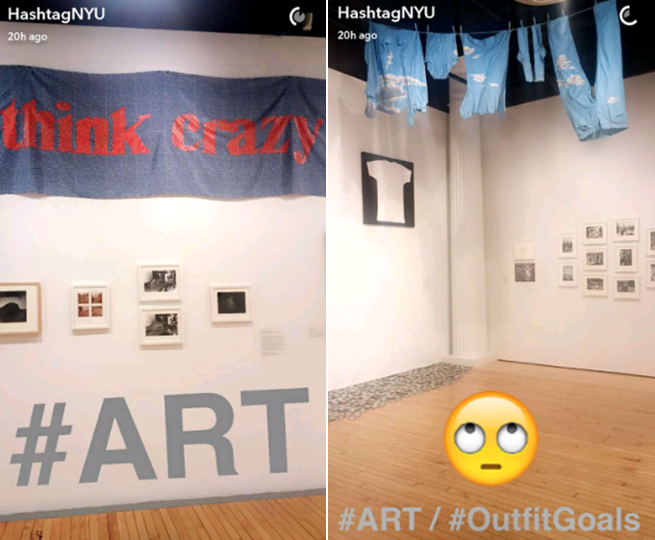
Another useful function of Memories is ‘Flashbacks’, a feature very similar to Facebook’s ‘Timehop’, which allows users to repost Snaps taken on the same date in previous years. Schools could use this function to draw attention to important dates or anniversaries, or reach out to current students or alumni on the platform to strengthen their connection with their existing community.
Example: Posts promoting campus events, particularly those featuring students, can be reshared using Memories to engage with those who attended. For instance, these pictures from Boston University’s recent Fall Arts Fair would be ideal for the format.

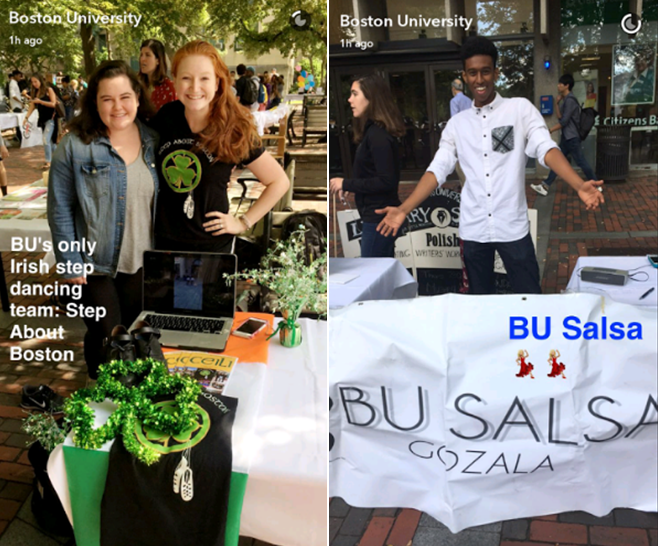
Like Instagram Stories, Memories attempts to move users away from the original functionality of the app, and it remains to be seen how well the current user base will take to the new features. However, if the feature is successful, it could make Snapchat even more important, winning over older users and cementing the platform as a comprehensive social media service and serious competitor in the wider marketplace.
Not only do Stories, Moments, and Memories offer social media users a far wider variety of ways to use each of these platforms, they also bring the overall functionality of each app much closer together. The new features will make Instagram, Twitter, and Snapchat far more similar, increasing the already fierce competition between the three companies.
With that in mind, any of these sites could see significant upturns or downturns in the future, as social media users make their choice and begin to migrate towards the more popular platforms. Online student recruitment professionals would be wise to monitor their social media performance closely over the coming months, carefully measuring their analytics to track the effectiveness of any new campaigns, and ensuring they know which social sites are favoured by their targeted personas.
Have you used Stories, Moments, or Memories yet? Have you found any of these features useful in connecting with prospective students? Join the conversation in the comments section below.






